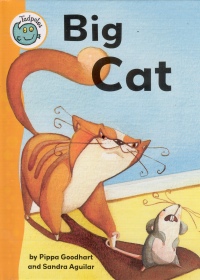| ________________
CM . . . . Volume XVIII Number 23 . . . . February 17, 2012
Big Cat features a cat who likes to chase and play with mice, but then the mice unite and 'get back' at Big Cat for his mischief. All ends happily with cat and mice as friends. Upon first reading, I expected this book to be a counting book (Cat begins with one mouse, then two, then three) but then after the third mouse, it jumps to six mice 'getting even' with Cat. This was a surprise.The text of this book is sparse and rendered in a large font. This approach makes it easy to read, but does require the reader to refer to the illustrations to enhance the story. Take the first four pages as an example: The text does not reveal what is unfair to the mice, but the illustrations show the cat first holding down one mouse's tail so the mouse cannot run away and then holding two mice by their tails so they can not escape. When I read this book with my three-year-old son for the first time, I found that I had to point out the nuances of the illustrations for him to understand. Older readers would be able to notice and understand such details more easily without assistance or guidance. Older readers who have a sense of 'playing fair' and of things being unfair would also better understand what the mice find unfair, and how and why they get 'revenge' on Cat. Repetition also plays a large part in this story. It does not detract from the story. In fact, it helps readers anticipate what is coming next and plays right into things turning around when the mice play with Big Cat, and to the conclusion when they all play together. Also repeated is the use of the ellipses which creates suspense and draws the reader to the next page. Illustrations of Big Cat and the mice show expressive faces which delight younger readers (my 11-month-old daughter squealed and smiled when she saw Big Cat on the first page) and allow older readers to make inferences about how the animals are feeling. The illustrations are appealing and have enough detail that readers will both want and need to examine them to enjoy them fully. Additional inclusions in this book are a list before the story of 'common words' and 'other words' which could be used in lesson planning, or just for informational purposes, and a "Puzzle Time" section at the back of the book (On which pages can you find these pictures?). There is an answer key as well as notes to adults containing suggestions of discussions and activities to use with this book. My fondness for Big Cat and its illustrations grows with each reading. Recommended. Karyn Miehl, a mother of two and a secondary school English teacher, lives in Kingsville, ON.
To comment
on this title or this review, send mail to cm@umanitoba.ca.
Copyright © the Manitoba Library Association. Reproduction for personal
use is permitted only if this copyright notice is maintained. Any
other reproduction is prohibited without permission.
NEXT REVIEW |
TABLE OF CONTENTS FOR THIS ISSUE
- February 17, 2012.
AUTHORS |
TITLES |
MEDIA REVIEWS |
PROFILES |
BACK ISSUES |
SEARCH |
CMARCHIVE |
HOME |
||||||
